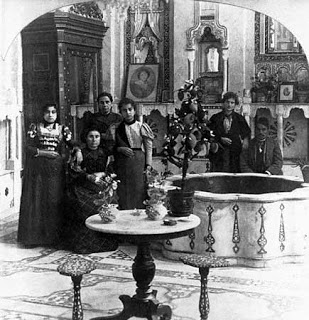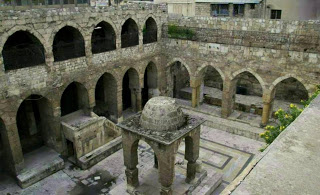
This article from Middle East Eye takes an interesting look at the Syrian-Jewish community of Manchester established by 19th century traders like Abraham Batis. But the antisemitic riots which devastated the Aleppan community in 1947 are passed over in silence, and the Baathist regime’s more recent oppression of the remaining Aleppan Jews attributed to a ‘multi-ethnic diversity lost to war’. (And there are odd mistakes: the industrialist Joe Dwek is called Dewek).
More than 150 years on from Batis’s voyage, this town also served as the final escape route for Aleppo’s last Jewish family, who were reportedly smuggled out of Syria and into Turkey with the help of an Israeli-American businessman and moderate rebels from the Free Syrian Army late last year.
That crossing effectively ended 3,000 years of Aleppan Jewish history – another element of Syria’s uniquely multi-ethnic, diverse history lost to war.
But the UK – and Manchester, specifically – retains its own place in the history of the Syrian Jewish diaspora, one with parallels to the modern-day migration flows arriving on Europe’s shores.
Jewish family in Damascus (Photo: Wikicommons)
Down leafy streets and Georgian terraces with bourgeois English gardens and driveways, it’s not immediately clear that Didsbury in south Manchester was, until last century, a hub for immigrants from around the Middle East.
In the so-called “millet of Manchester,” historian Fred Halliday wrotein the 1990s, food was one way multiple cultures mixed: “Kibbe and mujadarra on Saturday, English roast and apple pie and milk pudding on Sunday.” Even up until after the Second World War, it was common to hear Arabic spoken in the streets of Didsbury.
Tucked down a residential side street is the Shaare Hayim Synagogue, a solemn-looking, 900-capacity temple that first opened in 1927 and later became a hub for descendants of the many “oriental Jews” who moved to the UK’s industrial heartland between the mid-19th and early 20th century.
South Manchester was already home to Sephardic Jews, descendants of Jewish families originally expelled from Spain and Portugal in the 1400s. But they were later joined by Mizrahi (Arab) ( actually oriental – ed) Jews from the Middle East.
The Great Synagogue in Aleppo as it looked in 2011. The article makes no mention that rioters damaged it badly in 1947
Many of them, like Batis, came from Syria in the hope of establishing themselves in the heart of the UK’s industrial revolution.
Today at Shaare Hayim, Jews with origins in Egypt, Iraq, Lebanon, Yemen and – since the late 20th century – Iran sing and pray alongside the descendants of Syrian migrants. During the 1990s, the community amalgamated a series of mostly Syrian breakaway synagogues, whose congregations hadn’t thought much of the austere ceremonies presided over by Spanish and Portuguese Jewish immigrants.
More than 150 years on from Batis’s voyage, this town also served as the final escape route for Aleppo’s last Jewish family, who were reportedly smuggled out of Syria and into Turkey with the help of an Israeli-American businessman and moderate rebels from the Free Syrian Army late last year.
That crossing effectively ended 3,000 years of Aleppan Jewish history – another element of Syria’s uniquely multi-ethnic, diverse history lost to war.
But the UK – and Manchester, specifically – retains its own place in the history of the Syrian Jewish diaspora, one with parallels to the modern-day migration flows arriving on Europe’s shores.
Down leafy streets and Georgian terraces with bourgeois English gardens and driveways, it’s not immediately clear that Didsbury in south Manchester was, until last century, a hub for immigrants from around the Middle East.
In the so-called “millet of Manchester,” historian Fred Halliday wrote in the 1990s, food was one way multiple cultures mixed: “Kibbe and mujadarra on Saturday, English roast and apple pie and milk pudding on Sunday.” Even up until after the Second World War, it was common to hear Arabic spoken in the streets of Didsbury.
Tucked down a residential side street is the Shaare Hayim Synagogue, a solemn-looking, 900-capacity temple that first opened in 1927 and later became a hub for descendants of the many “oriental Jews” who moved to the UK’s industrial heartland between the mid-19th and early 20th century.
South Manchester was already home to Sephardic Jews, descendants of Jewish families originally expelled from Spain and Portugal in the 1400s. But they were later joined by Mizrahi (Arab) Jews from the Middle East.
Many of them, like Batis, came from Syria in the hope of establishing themselves in the heart of the UK’s industrial revolution.
Today at Shaare Hayim, Jews with origins in Egypt, Iraq, Lebanon, Yemen and – since the late 20th century – Iran sing and pray alongside the descendants of Syrian migrants. During the 1990s, the community amalgamated a series of mostly Syrian breakaway synagogues, whose congregations hadn’t thought much of the austere ceremonies presided over by Spanish and Portuguese Jewish immigrants.
– See more at: http://www.middleeasteye.net/news/disappearing-migration-routes-brought-aleppos-jews-manchester-1199438840#sthash.1iv07yc1.dpuf


Leave a Reply